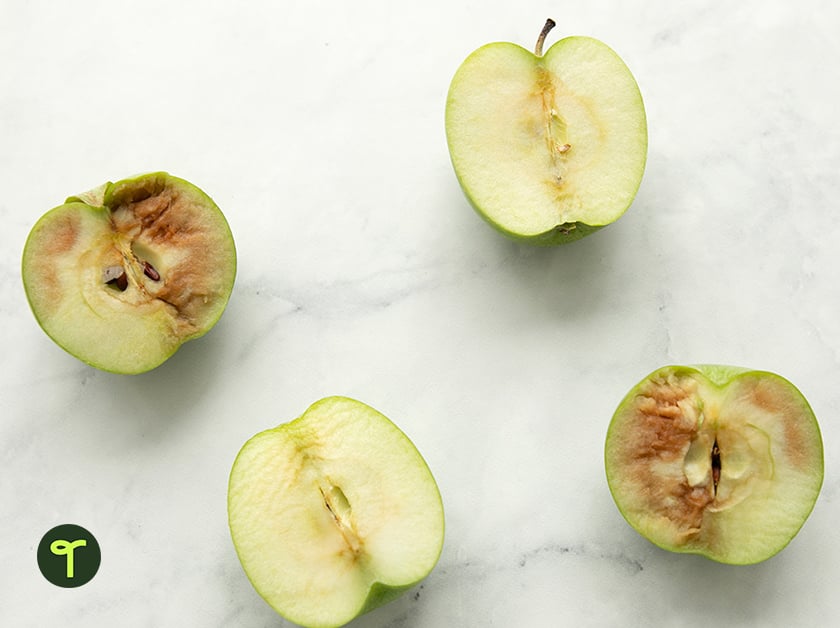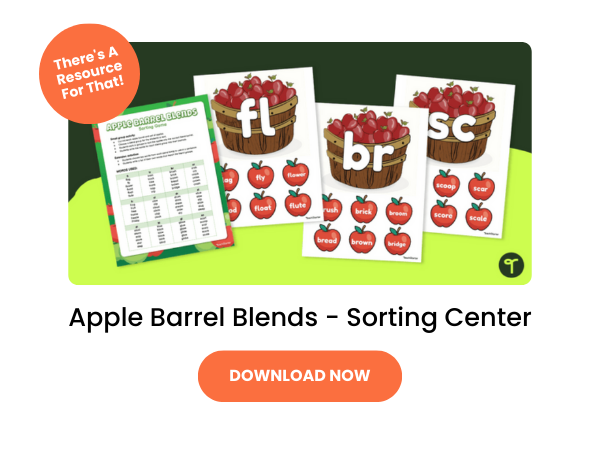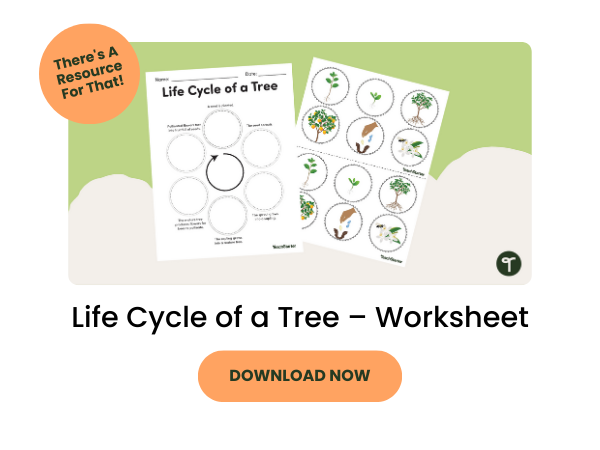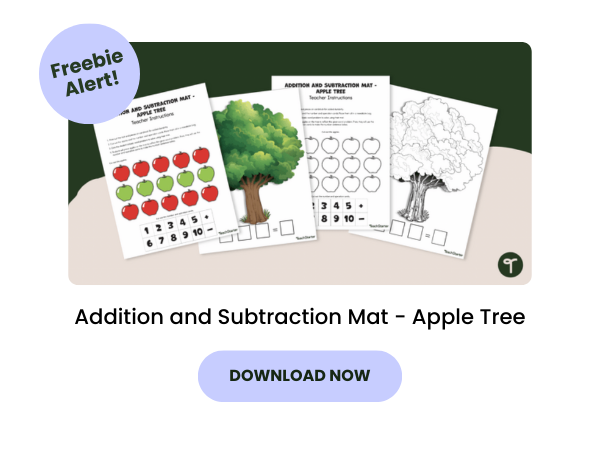When you think of fall, you probably envision crisp fall leaves, chubby pumpkins and, dare we say apples? Back-to-school season is synonymous with images of this classic red fruit, but September officially celebrates this sweet snack with Johnny Appleseed Day. When it comes to icebreakers and new routines this time of year, what better way to kick things off than with some Johnny Appleseed activities for kids?
If you’re looking for all things apples, you’ve come to the right place! The teacher team at Teach Starter has tracked down Johnny Appleseed history you can share with your students and engaging curriculum-aligned apple activities and apple facts for all ages!
Who Is Johnny Appleseed?
American folklore is chock full of legendary heroes from Molly Pitcher to Buffalo Bill and beyond. One of those heroes most Americans can say they’ve heard of is Johnny Appleseed — a wandering nurseryman who planted thousands of apple trees across the West. Johnny Appleseed’s image has been painted through the years as an eccentric outdoorsman wearing a burlap sack for a shirt and a cooking pot as a hat.
Keep reading to learn about the man behind the famous name!
Was Johnny Appleseed Real?
Unlike other legendary American folklore heroes like Paul Bunyan, Johnny Appleseed was — in fact — a real person named John Chapman who was born in 1774 in Massachusetts. Chapman planted his first apple tree nurseries in Pennsylvania in 1798 and continued to venture west, getting as far as Illinois or Iowa before his death in 1845.
John Chapman traveled ahead of the pioneers, predicting where they would settle down and planted nurseries in those locations. He wore a sack with holes for a shirt, often times had no shoes and carried a bag of apple seeds which is where he earned his famous nickname. Johnny was known for his wilderness skills, physical endurance and kindness to all animals, which its believed was closely tied to his religious beliefs.
While storybooks and cartoons portray Chapman planting sweet, cooking apples, he actually mostly planted cider apples along his route. These small varieties were used to produce hard cider, which was a staple of the American diet at the time since sanitary drinking water wasn’t readily accessible.
The first written account of Johnny Appleseed’s work appeared in Harper’s New Monthly Magazine in 1871, where his sugarcoated story acted as an innocent symbol of the conquest of the American continent.
When Is Johnny Appleseed Day?
John Chapman’s work is typically celebrated as Johnny Appleseed Day on the anniversary of his birth, September 26. Sometimes it is also celebrated on March 11, the anniversary of his death in 1845.
Johnny Appleseed Day Activities for the Classroom
There are plenty of fun ways you can celebrate Johnny Appleseed Day, especially with kids in your classroom! From learning about apples to incorporating them into your fall lesson plans, here are some ideas from our teacher team that you can try with your students:
1. Apple Math
Kids of all ages can learn and practice their math skills using apples. Here are a few fun apple-centric activities to try:
- Measuring the diameter of an apple with a measuring tape or a string with a ruler
- Counting the number of apples in a bucket
- Counting the number of seeds inside an apple
Our free printable Addition and Subtraction Apple Tree Mat can also come in handy as a minimal-effort math lesson:
2. Take a Field Trip
Is your school close to an apple orchard? Combine classes with another teacher in your school, and learn about where apples come from, how to make cider and perhaps try a sugary apple cider donut. If there isn’t one in your area, try a virtual trip such as this orchard visit with Caitie’s Classroom.
Tie your orchard trip to NGSS standards by focusing on the role of pollinators (bees, butterflies, etc.) in apple tree growth and seed dispersal!
Prior to your field trip, explain to your students how different animals help apple trees reproduce by carrying pollen from one flower to another and that this process is called pollination. While you’re at the orchard, make sure your students pay close attention to the insects or other pollinators visiting the flowers, as well as any other plants and animals they encounter on your class adventure.
When you return to school, set up some blank flower cutouts in spots around the classroom (you can grab a fun one from this behavior tracker). Next, pull out some snack foods that tend to leave residue on the fingers (Cheetos come to mind!), and have students get their fingers coated in the residue. Finally, let them loose to “pollinate” the flowers with their cheesy fingers!
You can also use your field trip to tie back to your math standards. Bring different varieties of apples back with you from the orchard (or have them on hand already), have the kids taste the different types and graph/tally the favorites.
3. Make Apple Boats and Predictions
Will apple boats sink or float? Work with your first graders to make predictions, and see what happens when they craft boats out of this fall fruit. This science experiment is good, clean fun, and you likely have most of the materials already at hand in the classroom.
Supplies
- Apples
- Toothpicks
- Foil
- Craft sticks
- Straws
- Scissors
- Water-filled containers (e.g., basins or trays)
- Graph paper for charting results
Project Instructions
- Break your class into groups of two to three students, and provide each group with an apple, as well as the other project supplies. Hold back the water-filled containers for your whole-class activity
- Explain their task is to design and construct a boat using the apple and various craft materials.
- Explain that they should consider factors that might affect whether or not their boat can float, such as the shape and size of their apple boat.
- After the time you’ve allotted for the group portion of the activity is complete, have students come back together.
- Call a representative of one group up at a time to place their group’s boat into your water-filled container to see whether it will sink or float!
- Provide each student with a graphing worksheet or draw a graph on the board/chart paper.
- Guide students in labeling the graph with the categories “Sink” and “Float.”
- Ask students to share their observations, and have them record the number of apple boats that sank and the number that floated, showing that they can count and represent data accurately.
4. Create Apple Crafts
When you finish your apple boats activity, you don’t have to let the leftovers go to waste!
Use leftover slices to create apple prints! Have your students simply dip an apple slice into some paint and stamp it onto their paper to create different shapes. You can also consider these additional ideas:
- Paper Plate Apples — Use ripped pieces of green or red construction paper and have students glue them onto a paper plate creating their own large apple.
- Dry Apples —Dry out some thin, round apple slices,and string them all together when they’re completely dehydrated for some fall classroom decor!
- Funky Apple — Try our printable Funky Apple craft with your students and compile them together for a cute back-to-school or fall-themed bulletin board:
5. Bob for Apples
This classic apple-based tradition may be fun as an outdoor activity for older students (with additional assistance from parent volunteers or colleagues). It’s also a fun activity you could add to a classroom Halloween party!
6. Read Apple Books
Use your morning meeting on Johnny Appleseed Day or just 10 minutes after recess to read aloud to your class. Here are some apple-themed books that are sure to get your students in the spirit of fall and Johnny Appleseed lessons:
- Apples, Apples Everywhere! by Robin Koontz
- Apples by Gail Gibbons
- Applesauce Day by Lisa J. Shipman
- How Do Apples Grow? by Betsy Maestro
- My Little Golden Book About Johnny Appleseed by Lori Haskins Houran
- The Biggest Apple Ever by Steven Kroll
- The Very Hungry Caterpillar by Eric Carle
7. Lead an Apple-Themed Anti-Bullying Activity
Johnny Appleseed was known for his kindness, so why not use his birthday to focus on kindness in your classroom with an apple-themed activity?
For this anti-bullying activity, you’ll need two apples that look similar. Take one apple and bang it up — you can toss it on the ground a few times — but make sure you don’t do any outside damage!
During your lesson, show students two apples that look the same, and ask them if either one is damaged (based on appearance only). Toss your damaged apple on the ground and tell the students (and the apple!) that this is the bad apple. Praise the other apple, and encourage the students to do the same.
Next, slice each “perfect” apple down the center, and expose the cross-sections. The undamaged apple will be perfect, but the dropped apple will be bruised on the inside, underneath the skin. Use this visual to help students understand that unkind words and actions can and will cause lasting emotional damage, which will remain unseen from the outside.

This powerful lesson deserves a place in your plans for regular learning experiences about bullying. By using a tangible symbol (two apples that look the same on the outside but when cut in half reveal the “hurt” inside), students can easily understand the impact of unkind words.
Apple Facts for Kids
Finally, you can share some fun apple facts with your students during the week of Johnny Appleseed Day, during the month of September, or as fun Friday facts! Write these on your whiteboard, use them as morning meeting discussion questions or just enjoy them as they are:
- Apples are in the same scientific family as roses.
- Apples grown in the United States come in more than 2,500 varieties, including Honeycrisp and Cortland.
- Crabapples are the only apples native to North America.
- Apple blossoms come in white and pink colors.
- Apples are the official fruits of New York, Vermont, Minnesota, West Virginia, Washington and Illinois.
- Michigan‘s state flower is the apple blossom.
- The United States, China, Italy, Turkey and Poland produce most of the world’s apple trees.
- In 2005, the heaviest apple ever picked was harvested in Japan, weighing 4 pounds.
- It takes around 36 apples to create one gallon of apple cider.
- Many people think apple pie is American, but it actually originated in England.
- In the 18th century, families in the U.S. and Europe would give teachers freshly picked apples to supplement their low wages. This is one reason why apples are common symbols of education.

- Pomologists are scientists who study and cultivate apples.
- Have you ever wondered why apples float in water? This is because they are 25 percent air!
- There are 7,500 varieties of apples grown around the world.
- Have you ever heard, “an apple a day keeps the doctor away?” Apples are great sources of fiber, with just one containing about 5 grams of fiber.
- Our first president, George Washington, was said to enjoy pruning his apple trees.
- The flesh of an apple is commonly white, but some varieties, such as Pink Pearl, contain flesh ranging from pink to bright red.
- One of North America’s most commonly known apples is the Red Delicious, discovered in Iowa.
- Apples are commonly measured in bushels. One bushel of apples weighs between 42 and 48 pounds.
- Eating apples can help naturally brighten your teeth because of their malic acid.
- Apples can be made into juice, vinegar, jelly, sauce, butter, pie and many other delicious items!














Comments